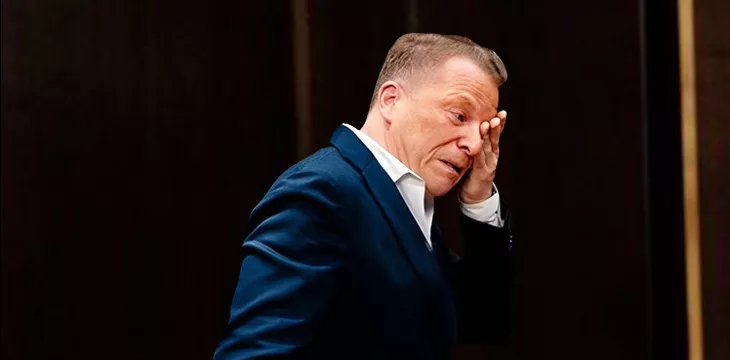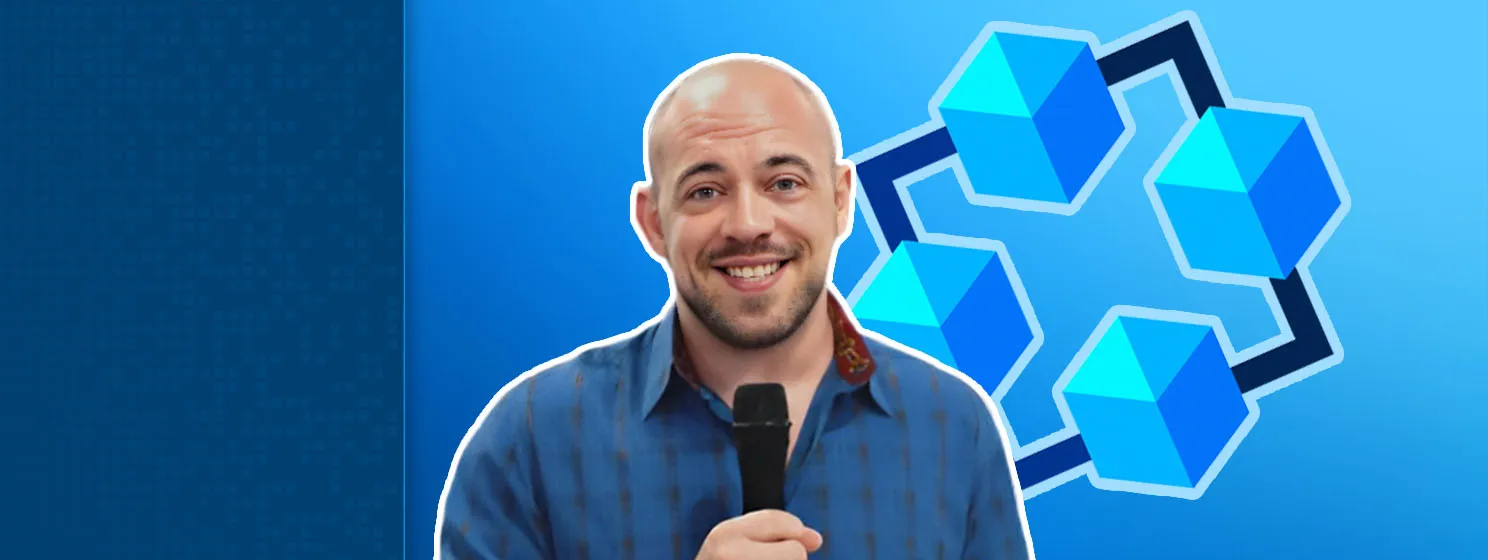|
Getting your Trinity Audio player ready...
|
Testimony given under oath through three weeks of the landmark Satoshi identity trial in London suggests that Christen Ager-Hanssen, the disgraced and ousted CEO of nChain, embarked on a campaign of litigation sabotage and character assassination aimed at ensuring victory for the Crypto Open Patent Alliance (COPA) against Dr. Craig Wright.
Ager-Hanssen, who was booted from nChain after what appears to be a failed IP-takeover gambit, has continued to hang around Dr. Wright’s litigation like a fly by providing inflammatory social media commentary and even attempting to send a witness statement to Justice Mellor, who is presiding over COPA v Wright. However, specifics about what precisely went down in September 2023 (when Ager-Hanssen was fired) have been scant, likely due to open litigation filed by nChain.
Now, thanks to the testimonies given so far in COPA v Wright and statements made before the proceedings began, a clear picture emerges of Ager-Hanssen going to absurd lengths to ensure that Dr. Wright has no chance at trial.
This began with Ager-Hanssen integrating himself with Dr. Wright’s legal strategy shortly after being appointed nChain CEO in December 2022. According to a witness statement filed by Dr. Wright on October 19, 2023, Ager-Hanssen took an ‘active role’ in Dr. Wright’s various lawsuits from January 2023, including the hand-picking of Zafar Ali KC, a notable barrister, to act as a ‘consultant.’ Dr. Wright then says in his testimony under oath that Ager-Hanssen and Zafar Ali appointed a new firm to take over his U.K. litigation from Ontier: Travers Smith.
This act alone would have served Christen Ager-Hanssen’s purposes in multiple ways. First, it would have had the effect of pulling control of Dr. Wright’s legal cases further within Ager-Hanssen’s sphere of control: no matter what Dr. Wright might think of Ontier’s results, they were a firm of his choosing that has been working on Dr. Wright’s diverse litigation portfolio for years. Now, that work was being done by an Ager-Hanssen appointee.
In addition, swapping Ontier with a firm appointed by Ager-Hanssen so close to trial would have had (and did have) a significant impact on Wright’s ability to prepare a defense, as Dr. Wright pointed out during his time on the stand. It left him scrambling to find expert witnesses with a sufficient range of knowledge to be able to give an honest assessment of documents that have been put through Dr. Wright’s decade-spanning ringer of server migrations and obscure file format conversions. Instead, Dr. Wright was stuck playing the hand that had been dealt him by Ager-Hanssen.
The pièce de resistance of Ager-Hanssen’s strategy was a so-called ‘mock trial’ surreptitiously arranged by Ager-Hanssen. The first the world at large heard of this trial was shortly after Christen Ager-Hanssen had been booted out of nChain, when the Norwegian businessman was desperately trying to seize control of the narrative.
As Ager-Hanssen tells it on social media, Dr. Wright and Stefan Matthews attended a pre-planned ‘mock trial’ to see how Dr. Wright would perform on the stand.
The idea that this would have been a pre-planned exercise agreed to by Dr. Wright and his team is absurd on its face: mock trials of this kind are clearly prohibited in the United Kingdom.
As we saw during witness testimony at the identity trial, it also isn’t true. At trial this week, when Stefan Matthews was asked about the mock trial while under oath at which Dr. Wright was supposed to have performed badly, Matthews immediately scoffed:
“He didn’t get [a] chance to perform at anything. It was an ambush and a one-way interrogation of Dr. Wright to, I think, force me as a witness to withdraw in this case.”
This tallies with what Dr. Wright had to say about it in his October witness statement. He says that just before September 21, when the mock trial took place, both he and his wife were invited by Ager-Hanssen and Ali for a two-day meeting to discuss litigation strategy. It was only when arriving at the meeting venue that Dr. Wright realized what Ager-Hanssen had planned: the room was laid out ‘in part, like a courtroom.’ The room was filled with cronies of Ager-Hanssen and Zafar, with the only other two attendees being Matthews and another business associate of his and Dr. Wright. Dr. Wright then described being grilled on his case by Zafar under the watch of someone who claimed to be a Judge (Dr. Wright notes he had his doubts):
“Zafar then aggressively questioned me, with the questions premised on me not being Satoshi Nakamoto and that I had forged documents in the litigation.”
Thereafter, a ‘heated exchange’ ensued between Dr. Wright, his wife, and Matthews on the one hand and Ager-Hanssen on the other. Ager-Hanssen tried to pressure Dr. Wright to ‘admit’ that he did not create Bitcoin. Ager-Hanssen also threatened Matthews, telling him that if he testified on behalf of Dr. Wright as planned, he would be liable for perjury. Ager-Hanssen also talked separately with Dr. Wright’s wife, trying to arrange a one-on-one lunch so that a ‘deal’ could be done.
“From this, I infer that Christen was in fact referring to him acquiring the shares and/or intellectual property of nChain,” reads Dr. Wright’s witness statement.
Ager-Hanssen subsequently began sending screenshots of Dr. Wright’s browsing history to his wife, which were obtained from one of his laptops by using his position at nChain to use “a policy install attached to software from nChain Ltd to push unauthorized changes to my system.” This is what tipped Dr. Wright off to the scale of Ager-Hanssen’s deception, leading him to file a report with both nChain and the police.
In response to this, nChain opened an investigation, called a board meeting, and dismissed Ager-Hanssen.
Matthews’ testimony this week shed ever more light on this episode, though details are scant given that nChain, Matthews confirmed, is in the process of a multi-front legal action against Ager-Hanssen.
“I was alerted to the fact that Christen Ager-Hanssen had instructed the support team to open up nChain email boxes for eight people for Ager-Hanssen to review. One of those was mine. The systems support team thought this was unusual and improper, so they referred it to me.”
Matthews says he immediately told support that Ager-Hanssen’s request was not authorized, with Ager-Hanssen copied in. This, apparently, caused Christen Ager-Hanssen to make one last desperate grasp for power:
“Ager-Hanssen tried to take over nChain in London, escorting a number of people out of the building, taping up CCTV cameras, shredding documents, and physically broke into our server room to remove CCTV footage. He was terminated that night,” Matthews told the court.
This would be a stunning testimony, even if it was just limited to the nChain break-in. However, in light of what Dr. Wright consistently said in response to being accused of forgery on the stand, Ager-Hanssen’s actions become even more troubling. A key item of evidence in this case is the so-called BDO drive, found on a hard drive at the bottom of a drawer, which Dr. Wright said hasn’t been touched since 2007. It was, therefore, supposed to be a perfect time capsule from the year or so before Bitcoin was released and likely contained irrefutable, untampered-with evidence that Dr. Wright was working on Bitcoin at the time.
Except following Ager-Hanssen’s termination, he began posting excerpts and screenshots of files contained on that drive to Twitter, demonstrating that he had, and may have continued to have, access to the BDO drive.
That’s why, when experts examining the drive in preparation for the case discovered that it contained many documents showing signs of manipulation, Dr. Wright knew precisely who was to blame.
That much was made obvious from Ager-Hanssen’s history with Dr. Wright and nChain. But it was also made obvious when, in court, COPA’s barrister began showing Dr. Wright the supposedly forged documents—not just from the BDO drive, but from the wide pool of documents that have been submitted for the case. They did indeed seem to be forgeries (feeble ones)—but in trying to frame Dr. Wright for them, whoever was really responsible accidentally gave up the game.
As an example, take a photograph of a computer monitor purporting to show accounting records, which would prove that Tulip Trading Limited and Wright International Investments Ltd were incorporated and transacted in 2009—contrary to COPA’s case. Except clues from what is displayed on the monitor indicate that the photograph is actually of Dr. Wright’s setup: the Windows 10 taskbar shows as open a number of documents that relate to Dr. Wright, such as an ‘LLM proposal,’ while the monitor itself appears extremely close (but not that close) to the one confirmed as being used by Dr. Wright. In other words, COPA thought it had another slam-dunk forgery it could throw at Dr. Wright.
Except, Dr. Wright pointed out that his machine, hyper-specialized as it is, is the only one in nChain that uses Windows 11, while the machine photographed is clearly using Windows 10. Dr. Wright pointed out that it would make sense for Ager-Hanssen, in planting these photographs, to assume Dr. Wright used Windows 10 because that is the group policy at nChain. In other words, all COPA had done was demonstrate that this document—and now, in the eyes of the judge, countless others—was planted by someone other than Dr. Wright.
It wasn’t the first time a forgery shown to Dr. Wright by COPA has backfired in this way. Ira Kleiman seemingly had the same idea as Ager-Hanssen while he was preparing for the Kleiman v Wright. He planted an email making it look like Dr. Wright had partnered with his late brother to invent Bitcoin in 2008, not realizing that the email address used to finger Dr. Wright as the author referenced his current wife and children, whom he had not met in 2008.
Given the scale of the forgeries being alleged against Dr. Wright, it defies belief that Dr. Wright would have been responsible for them, particularly given his position—as told to the court—that the drive was effectively a time capsule from 2007. If Dr. Wright had anything to do with those forgeries, then this story would only have served to make them more conspicuous and obvious to the Judge. COPA knew this, and they spent much of the final days of Dr. Wright’s first week on the stand, grilling him about those very forgeries.
But what would the judge make of all this? Consider what he’s seen:
- Witness statements from Dr. Wright describing how Ager-Hanssen, almost immediately after becoming CEO of nChain, took control of Dr. Wright’s litigation, appointing cronies and a law firm of his choosing to manage the cases, less than a year out from the most important case of Dr. Wright’s life.
- Ager-Hanssen then organized a mock trial (this point is not disputed by anyone), which in and of itself if a significant breach of U.K. litigation rules. He used this trial to harass and berate Dr. Wright, his wife and Stefan Matthews, with the express purpose of getting Matthews to withdraw as a witness and with the implied purpose of gaining control of Dr. Wright and nChain’s IP.
- Ager-Hanssen made a public spectacle of his exit from nChain, sharing confidential information on X (formerly Twitter) while making threats to Dr. Wright and his witnesses for this case – all of which is in the public domain.
- Stefan Matthews’ lengthy testimony, which describes how Ager-Hanssen threatened to destroy his and his family’s lives if he didn’t withdraw as a witness from the case. He also gives the best—probably the only—public account of what really went down with Ager-Hanssen at nChain, which involved Ager-Hanssen breaking into nChain’s server room and stealing CCTV footage all the while trying to gain access to the inboxes of nChain’s executive team.
- Finally, in the courtroom, Dr. Wright is presented with scores of documents that are apparently manipulated, many of which don’t lend any credence to Dr. Wright’s claim and some of which point so directly at Dr. Wright that it is near-impossible to view them as anything but a bad frame-job.
In light of all of these facts, it is difficult to view Ager-Hanssen’s behavior from the moment he met Dr. Wright as anything but a scheme to destroy Dr. Wright’s credibility before the COPA trial and, failing that, force the witnesses who corroborate his account of Bitcoin’s invention to withdraw out of fear. Fortunately, Matthews held fast, but the two people who saw Dr. Wright use Satoshi’s keys with their own eyes—Jon Matonis and Gavin Andresen—are unwilling to participate in the case.
The real question—and no doubt a question that has already occurred to Justice Mellor in light of the above—is precisely what COPA had to do with Ager-Hanssen’s actions. Viewed from almost any angle, it is they who benefit the most from Ager-Hanssen’s behavior.
To tie one final bow around the facts set out above, consider the bombshell dropped by Dr. Wright while on the stand in the first week of trial: one of the sets of documents Dr. Wright did send to Ager-Hanssen apparently contained a tracking cookie, which informed him that it had been opened at an IP address pointing to the offices of Bird and Bird, attorneys for COPA.
No matter the conclusion you draw from that, it is clear that Ager-Hanssen has dedicated a full year of his life—probably longer—to making sure that COPA wins their case against Dr. Wright. As for COPA’s involvement in that plan, one might speculate that this will be a future matter for another court just as soon as Dr. Wright wins in front of the present one.
Check out all of the CoinGeek’s special reports on the Satoshi Trial (COPA v Wright).

 07-27-2025
07-27-2025 





